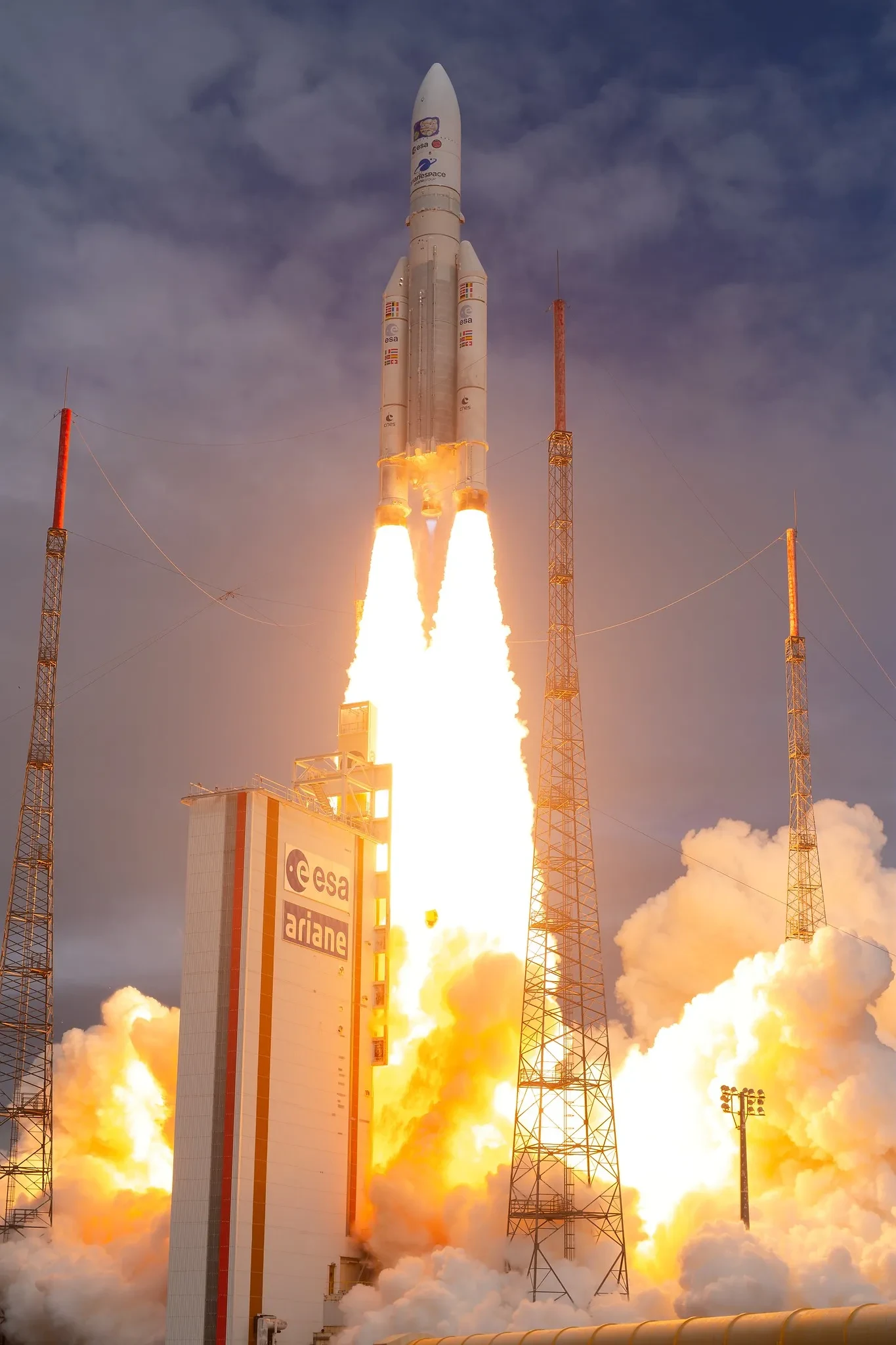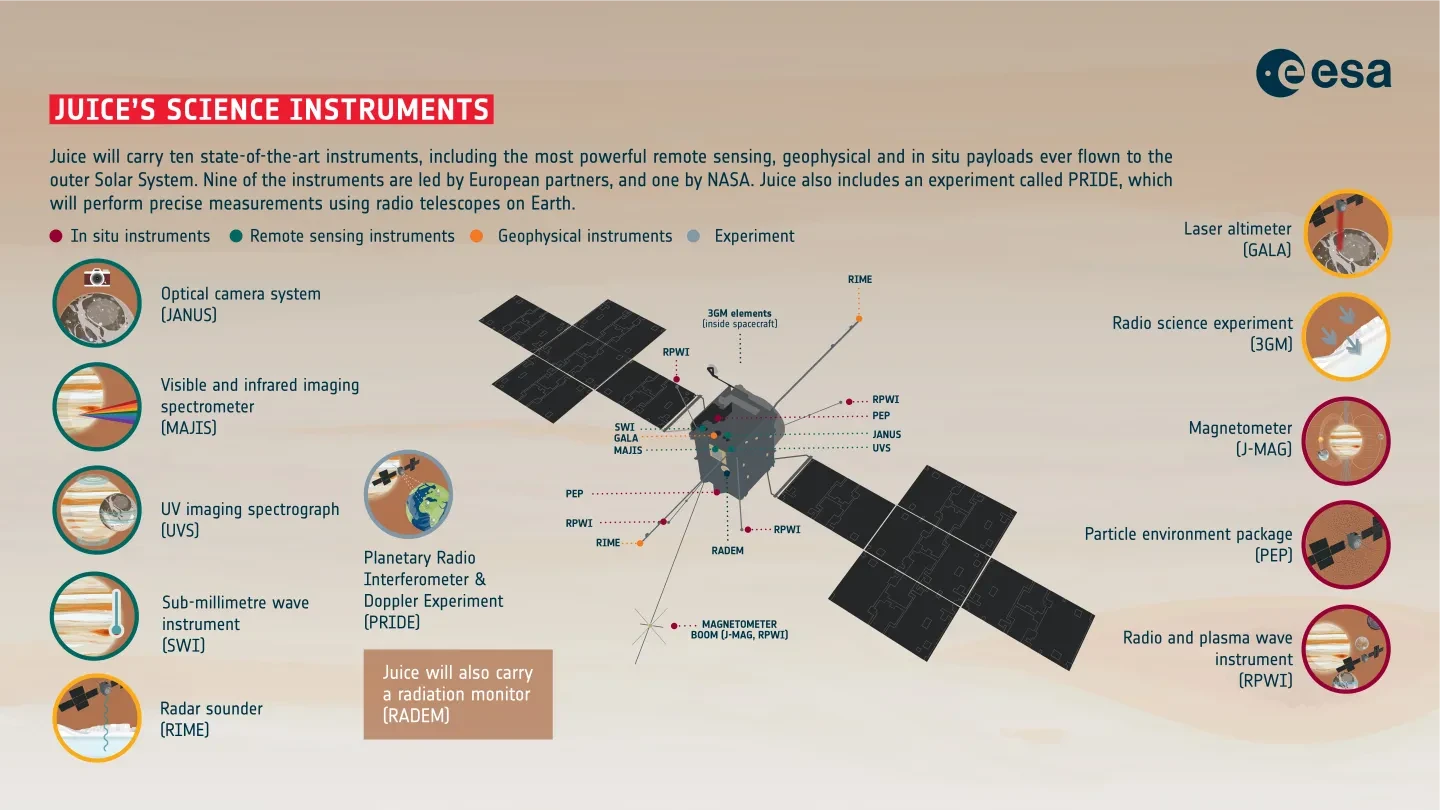
How habitable are Jupiter's icy moons? Why is the Solar System's largest moon so unique? How did Jupiter, and other gas giant planets, form? Find out how the European Space Agency's groundbreaking JUICE mission will answer these questions and more.
What is the JUICE mission and why is it going to Jupiter?

Full disclosure – I am fascinated by Jupiter and the wider Jovian system. In between working the two roles I’ve had in the Education Team at the Royal Observatory Greenwich, I completed a PhD to study Jupiter’s X-ray aurorae. As such, I am very excited about JUICE!
JUICE (JUpiter ICy moons Explorer) is a mission led by the European Space Agency (ESA) that will explore Jupiter and its three large icy moons, Ganymede, Europa and Callisto, over the course of four years. Its main purpose is to confirm whether these moons have seas of liquid water below their icy surfaces and whether they might have the conditions for life.
Ganymede is unlike any other moon in our astronomical neighbourhood – it is larger than Mercury, generates its own magnetic field, and has aurorae that work in a similar way to the Earth’s.
If there is life elsewhere in the Solar System then one of the most likely places to find it is Europa.
Meanwhile, Callisto is thought to have the oldest surface in the Solar System that has not been renewed since it was formed. Therefore, studying it will give us a glimpse at what the Jovian system was like when it was forming. These three moons are described as icy moons which have icy crusts and potentially seas of liquid water below the ground.
The fourth and final Galilean Moon is Io. Unlike Ganymede, Europa and Callisto, Io does not have ice or liquid water. Instead, it has hundreds of active volcanoes and lakes of lava on its surface. Roughly 1000kg of volcanic material is ejected every second by Io into the space environment around Jupiter. Although JUICE will not make any close flybys of Io, the mission will measure how Io’s volcanic activity affects Jupiter and the other Galilean moons.
The JUICE mission will also give us an insight into how Jupiter’s atmosphere works, as well as further our knowledge of how Jupiter got its rings and its smaller moons.
The 5 big questions JUICE aims to answer are shown in the infographic below.
How will the JUICE mission get to Jupiter?
JUICE was launched on 14 April 2023 from the European Spaceport in French Guiana, which is in the northeast of South America. An Ariane 5 rocket was used to take JUICE into space before they separated about half an hour after the launch.
Ariane 5 is one of the most reliable launch vehicles and has launched many space science missions, such as XMM-Newton (my favourite space telescope), Rosetta and JWST.
Jupiter is too far away for the JUICE mission to get to directly, so it will fly by the Earth and Moon, Venus and then the Earth again twice more. The spacecraft will use these bodies’ gravity to give it a speed boost. If all goes well, JUICE should reach Jupiter in July 2031 and will have enough fuel to make 35 flybys of the icy moons before orbiting Ganymede from December 2034.
Instruments onboard the JUICE mission
Onboard JUICE are 10 cutting-edge scientific instruments and one experiment that were specifically designed and chosen to help JUICE complete its mission.
JANUS is an optical camera that will take stunning photographs and will give the broad geological overview of what the other instruments are looking at.
MAJIS (Moons and Jupiter Imaging Spectrometer) will determine the chemical composition and minerals of the surfaces of the icy moons, and it is even capable of detecting organic molecules if they are present on the moons. Finding these building blocks of life will increase the moon’s potential to harbour life. It will also look for cloud features on Jupiter.
SWI (Sub-millimeter Wave Instrument) will also study the surfaces and thin atmospheres of Ganymede, Europa and Callisto in a similar way to MAJIS and UVS but will look for frequencies of light that are in between that which MAJIS and UVS can detect.
GALA (Ganymede Laser Altimeter) is a laser altimeter which can measure the depth and height of features on the moons, allowing it to make 3D maps of the moons.
A radar sounder called RIME (Radar for Icy Moons Exploration) will help astronomers see up to 9 km below the moons’ surfaces that will show what their icy crusts are like.
The gravity fields of the moons will vary from location to location depending on if that region of the moon is more or less dense. As JUICE flies over these different regions it will feel a slightly stronger or weaker pull of gravity from the moon which will affect its flight in a tiny way. 3GM (Gravity & Geophysics of Jupiter and Galilean Moons) will measure those changes in the gravity fields while the PRIDE (Planetary Radio Interferometer & Doppler Experiment) experiment will precisely measure the spacecraft’s speed and position.
The 4 instruments I’m most excited about are UVS (UV imaging Spectrograph), PEP (Particle Environment Package), RPWI (Radio and Plasma Wave Investigation) and J-MAG (JUICE-Magnetometer).
UVS and PEP will be able to confirm whether Ganymede really does have water vapour in its thin atmosphere and if plumes of water are erupting out of Europa’s surface. UVS will also look for the ultraviolet aurorae on the icy moons and Jupiter itself.
RWPI will measure the radio waves emitted by Jupiter and characterize the plasma that is found around Jupiter and the moons. Finally, J-MAG will measure Jupiter’s and Ganymede’s magnetic fields and how they interact with each other, and it can also be used to study the icy moons’ underground seas. PEP, RPWI and J-MAG in particular will help us understand how Jupiter and the Galilean Moons shape each other and how their interactions help to produce the aurorae on these different worlds.
To power the spacecraft and its instruments, JUICE has an array of 10 solar panels that have a total surface area of about 85 square meters. These solar panels would produce enough energy to power a whole street of houses if placed around the Earth, however, Jupiter is five times further away from the Sun than the Earth which means that it receives 25 times less sunlight than we do. Therefore, when JUICE reaches its destination, the solar panels will only produce enough energy to power a microwave.
What's the difference between JUICE and other missions to Jupiter?
JUICE is ESA's first venture to Jupiter, but it is not the first spacecraft to visit the king of the planets. So far seven spacecraft (Pioneer 10, Pioneer 11, Voyager 1, Voyager 2, Ulysses, Cassini-Huygens and New Horizons) have made passing visits to the gas giant planet, while Galileo and Juno are the only two to orbit and study the Jupiter system over a long period.

Galileo
Galileo was in orbit around Jupiter between 1995 and 2003, becoming the first spacecraft to orbit a gas giant planet. Galileo’s path around Jupiter was designed so that it could get up close to the Galilean Moons. Over its lifetime, the spacecraft made 34 flybys of those moons plus an additional flyby of a small moon called Amalthea. So far Galileo is the only Jovian mission to bring with it a descent probe that plunged into Jupiter’s atmosphere.
The probe lasted for 58 minutes and reached a depth of about 200 km, all the while taking measurements such as the temperature, pressure, and chemical composition of Jupiter’s atmosphere. Using data from Galileo and its probe, scientists discovered that Europa, Ganymede and Callisto have a layer of salty liquid water underneath their icy crusts. Other notable results include the detection of Ganymede’s magnetic field and that Jupiter has lightning strikes that are 1000 times more powerful than what the Earth experiences.
Image credit: NASA

Juno
NASA’s Juno spacecraft reached Jupiter in 2016 and is planned to stay in orbit until 2025. Its unique orbit during its primary mission took Juno over Jupiter’s north and south poles which allowed it to make maps of the whole planet and to get the best views of Jupiter’s northern and southern lights.
This polar orbit also prevented Juno from entering the most intense parts of Jupiter’s radiation belts that would damage the spacecraft. However, this type of orbit meant that Juno could not get close to any of the moons.
The spacecraft’s orbit was changed slightly after its mission extension in 2021 which means that flybys of Ganymede, Europa and Io are now possible. Juno’s main focus was Jupiter itself, namely mapping and characterising the planet’s atmosphere, magnetic and gravitational fields and aurorae. Part of the aim of Juno’s extended mission is to help plan for upcoming missions to Jupiter, including JUICE.
Image of the Juno spacecraft, credit: NASA/JPL-Caltech/Stony Brook University

Europa Clipper
NASA is planning to launch another spacecraft to Jupiter called the Europa Clipper in October 2024. It will take a different route to Jupiter than JUICE and will use gravity assists from the Earth and Mars rather than Venus. This will give the Europa Clipper a shorter journey time which will bring it to Jupiter around April 2030. As its name suggests, this mission will focus on Europa and is planned to make 50 close flybys of the icy moon. Its main science objective is to find out if any part of Europa could support life.
Although JUICE and Europa Clipper have different priorities, there will be plenty of chances for the two to collaborate, and scientists from both missions are already coming up with a plan on how to make the most of this exciting opportunity.
Image of the Europa Clipper, credit NAS/JPL-Caltech
How will the JUICE mission end?
Once JUICE completes its mission the plan is to crash it into Ganymede to ensure that it does not collide with Europa and potentially contaminate it with microbes from the Earth carried by the spacecraft.
Ganymede is not thought to support life on its surface so even if terrestrial microbes do make it there, they will not pose any danger to any life that might exist below the surface. If during the mission there is even a small suspicion that native lifeforms might be found at or near Ganymede’s surface, then the plan to end the mission on it will change.
People involved in JUICE
Although ESA are leading the mission, JUICE is a truly global endeavour involving 18 institutions and 83 companies from 23 different countries. NASA provided the UVS instrument plus parts for RIME and PEP, JAXA (the Japanese Space Agency) contributed to RPWI, GALA and PEP, while the ISA (the Israel Space Agency) supplied hardware for 3GM.
The UK is also heavily involved in JUICE. UKSA (the UK Space Agency) is the lead funder for J-MAG and this instrument is led by researchers at Imperial College London. Other UK universities that have built and developed parts for JUICE are the Open University (JANUS) and the Mullard Space Science Laboratory, UCL (PEP). More than 2000 people have worked to bring the mission to life.
Find out more
Professor Geraint Jones from UCL’s Mullard Space Science Laboratory and a member of the JUICE science team recently spoke about what astronomers hope to learn about Jupiter and its icy moons from JUICE in our Think Space lecture series. You can watch the recording of his talk on the Royal Observatory's YouTube channel.









